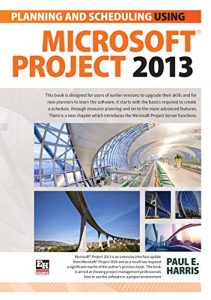This book is designed for users of earlier versions to upgrade their skills and for new planners to learn the software. It starts with the basics required to create a schedule, through resource planning and on to the more advanced features.
Microsoft® Project 2013 is an extensive interface update from Microsoft® Project 2010 and as a result has required a significant rewrite of the author’s previous book. This book is aimed at showing project management professionals how to use the software in a project environment.
This publication was written so it may be used as:
•A training manual, or
•A self-teach book, or
•A user guide.
The book stays focused on the information required to create and update a schedule with or without resources using Microsoft® Project 2013 by:
•Concentrating on the core functions required to plan and control a project.
•Keeping the information relevant to each topic in the appropriate chapter.
•Providing a quick reference at the start of each chapter listing the chapter topics.
•Providing a comprehensive index of all topics.
The book is aimed at:
•Project managers and schedulers who wish learn the software, however are unable to attend a training course, or require a reference book.
•Project management companies in industries such as building, construction, oil & gas, software development, government and defence who wish to run their own software training courses or provide their employees a good practical guide to using the software.
•Training organizations who require a training manual to run their own courses.
About the Author:
Paul Harris holds an Honours Degree in Civil Engineering obtained in the UK and is a Certified Cost Engineer through AACE International, a certified PRINCE2™ practitioner and Approved PRINCE2™ Trainer. He has worked in the project controls industry for a number of years and has assisted many companies in a range of industries to set up and run project controls systems. His Melbourne, Australia based company, Eastwood Harris Pty Ltd, offers project controls consulting and training services with a strong focus on Microsoft and Primavera software.
Microsoft® Project 2013 is an extensive interface update from Microsoft® Project 2010 and as a result has required a significant rewrite of the author’s previous book. This book is aimed at showing project management professionals how to use the software in a project environment.
This publication was written so it may be used as:
•A training manual, or
•A self-teach book, or
•A user guide.
The book stays focused on the information required to create and update a schedule with or without resources using Microsoft® Project 2013 by:
•Concentrating on the core functions required to plan and control a project.
•Keeping the information relevant to each topic in the appropriate chapter.
•Providing a quick reference at the start of each chapter listing the chapter topics.
•Providing a comprehensive index of all topics.
The book is aimed at:
•Project managers and schedulers who wish learn the software, however are unable to attend a training course, or require a reference book.
•Project management companies in industries such as building, construction, oil & gas, software development, government and defence who wish to run their own software training courses or provide their employees a good practical guide to using the software.
•Training organizations who require a training manual to run their own courses.
About the Author:
Paul Harris holds an Honours Degree in Civil Engineering obtained in the UK and is a Certified Cost Engineer through AACE International, a certified PRINCE2™ practitioner and Approved PRINCE2™ Trainer. He has worked in the project controls industry for a number of years and has assisted many companies in a range of industries to set up and run project controls systems. His Melbourne, Australia based company, Eastwood Harris Pty Ltd, offers project controls consulting and training services with a strong focus on Microsoft and Primavera software.






